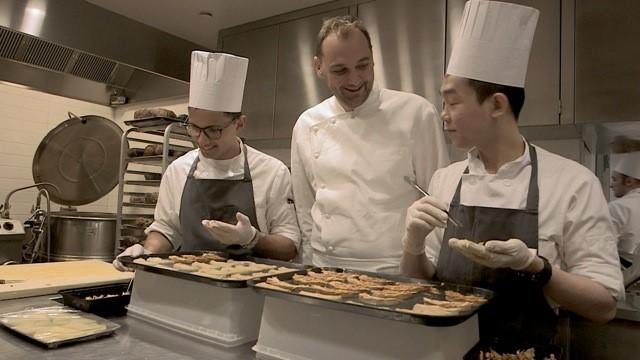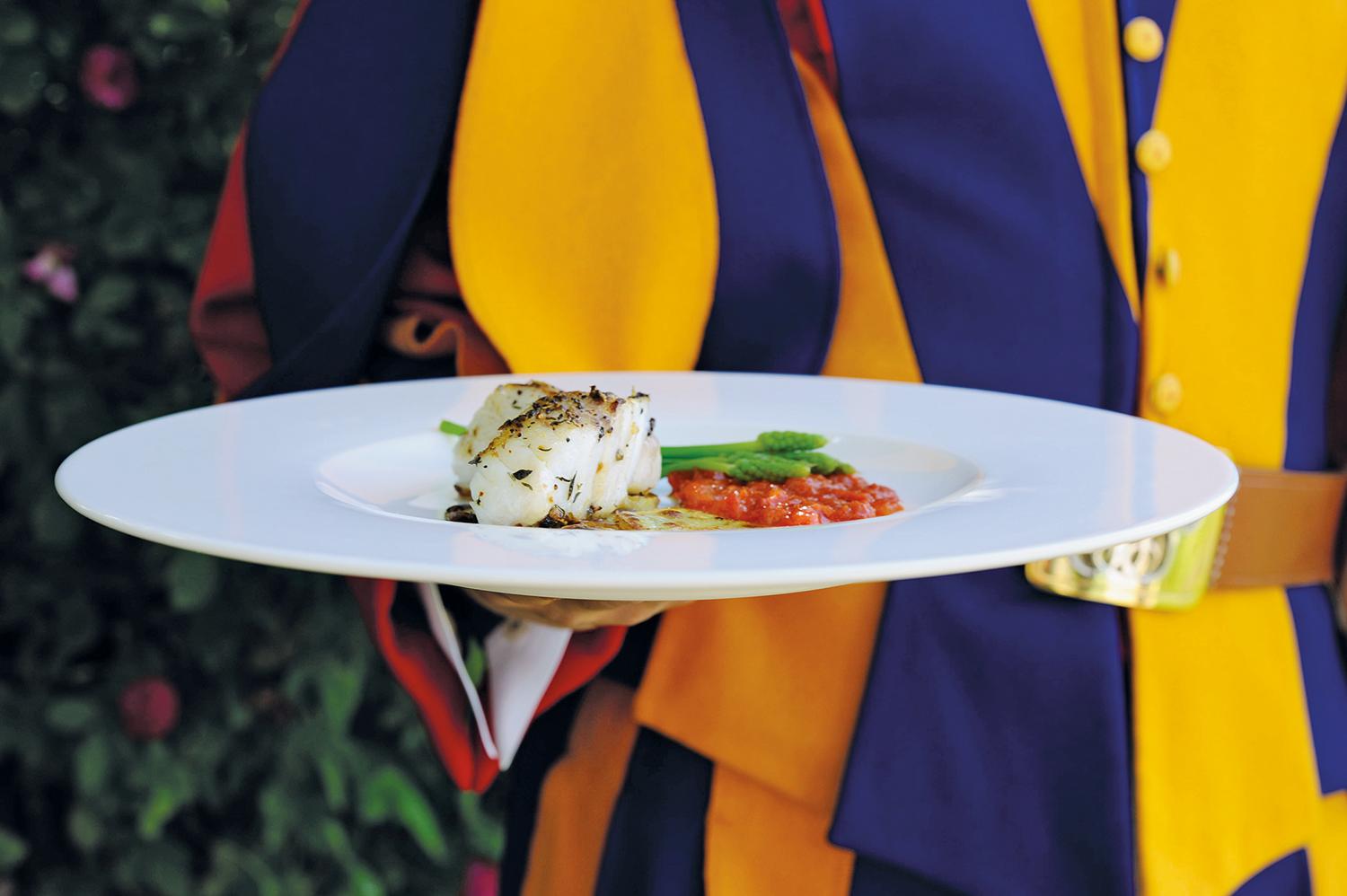Swiss chef Luc Liebster blends cultures with unique culinary creations

Swiss chef Luc Liebster has trained in some of the finest kitchens. Now he plans to open a restaurant in Mexico City, where food is revered.
“I like small kitchens where everything is close together,” says Liebster. His current restaurant kitchen is temporary and just a few square metres in size.
SWI swissinfo.ch meets Liebster while he is cooking as a guest chef at Canopia, a wine bar in a central neighbourhood of Mexico City. Pop-up events like these, where a top chef takes over the kitchen for a day, have become popular in this bustling metropolis.
At 26, Liebster has already built an impressive résumé. He started his culinary apprenticeship at Hotel Waldhaus, a small castle towering over the Swiss mountain village of Sils Maria in the Engadine region, when he was just 15 years old.
He carried with him pastry recipes passed down from his Czech grandmother during her time in Vienna. “The passion for cooking runs through my whole family,” says Liebster, though he’s quick to point out that this didn’t automatically mean he’d end up in a professional kitchen.
His mentor at the Waldhaus had been named Teacher of the Year, and Liebster wanted to learn from someone of that calibre. “Cooking wasn’t my childhood dream job,” he recalls. “I just needed to choose an apprenticeship and decided to go with it.” He later graduated top of his class.
Grasshoppers and Gruyère
A decade on, Liebster is now the one instructing Mexican chefs. For a foreigner, this is an honour in a country where everything to do with food is sacred.

In fluent Spanish, he calmly explains to his colleagues how to prepare the dishes, while the base sizzles in oil. The menu includes deep-fried Hungarian flatbreads (langos), topped with his own creations such as cheese sauce, truffle paste and trout with mustard seeds. His love for Mexican cuisine is inked on his forearm in the form of a chili pepper.
“But I’d never claim to cook authentic Mexican food as a Swiss,” he says. “To do that, you’d need to be Mexican. I want to develop my own style.”
SWI swissinfo.ch: How would you describe your style of
cooking?
Luc Liebster: I call it Luc food. It’s a fusion of influences from my experiences in Switzerland, Austria and Mexico.
SWI: What does that look like in practice?
L.L: When I cook at events in Switzerland, I might serve vegetables with a grasshopper dip, or a tostada [deep-fried tortilla, editor’s note] with Gruyère cream. I also make white asparagus with hollandaise sauce, incorporating spicy marinated Chicatana ants.
SWI: How do the Swiss react to the Mexican grasshoppers?
L.L.: They at least give it a try, and that’s what counts. I think people come for the experience. Mexican food is becoming more popular in Europe, but there aren’t many truly authentic restaurants in Switzerland yet.
The culinary Olympus of Vienna
Liebster’s sources of inspiration for his fusion cuisine are vast, drawing from a treasure trove of culinary experiences. After his first job, he set his sights on working at “the best restaurant in the German-speaking world”. That led him to Vienna’s Steirereck, where he eventually joined the team after flying there twice to prove himself.
At Steirereck, he mastered dishes such as aubergine with sea fennel, chicken knuckle with apricots and elderflower buttermilk ice cream. He describes his time there as his most formative experience.
“The Steirereck is a unique school for any chef,” he says.
It’s where he learned “lived sustainability,” something that has influenced him and that he’s now bringing to Mexico through several consulting roles.
A pioneer of Mexico’s new cuisine
“I never wanted to stay in one restaurant for more than two years,” says Liebster. After Steirereck, he worked at an Austrian hotel with top-tier cuisine, while spending holidays in Mexico. It wasn’t long before his next goal became clear.
He sought out Mexico City’s Pujol, the renowned restaurant run by gastronomic icon Enrique Olvera, ranked among the world’s top 20. Olvera was the first to elevate Mexican cuisine to fine dining standards at the turn of the millennium.
In our Guide to Moving Abroad you will find tips for emigrating from Switzerland and living abroad.
At 24, Liebster was hired as sous chef, despite not knowing most Mexican dishes before arriving. At Pujol, he learned to prepare refined versions of traditional Mexican fare, such as tacos with spicy peanut sauce, lobster with capers and corn pancakes with fig leaf sorbet.
Liebster says he found “the most motivated staff of my career” at Pujol. In Mexico, food is sacred and guests expect high standards. “At home, their grandmother cooks the best meals, and they expect the same quality in restaurants,” he notes.
Opening his own restaurant
True to his philosophy of never staying too long in one place, Liebster left Pujol a few months ago. Now, he is preparing to open his own restaurant. Hungarian langos will feature on the menu, but he won’t be in the kitchen every day. He’s also found a new calling as a restaurant consultant, and Mexico’s vibrant culinary scene has recognised his unique talents.

‘I just cook food’
The Swiss embassy in Mexico recently commissioned Liebster to cater for an event with 350 guests from politics, media and culture, after Liebster beat out other chef competitors.
However, Liebster’s ambitions go beyond this. “The goal is to find a prime location for a fine dining restaurant in Mexico City,” he says. That’s his real, long-term project.
SWI: So, you’re aiming for the high-end market?
L.L.: I love fine dining. But I often tell myself, “At the end of the day, I’m just cooking food.”
SWI: So, you’re staying humble?
L.L.: You can’t take yourself too seriously. You need to enjoy what you do. If I and my team enjoy our work, the customers will feel it too. A kitchen is always under pressure, but it should be positive pressure.
SWI: Is that possible? The restaurant industry is known for being tough.
L.L.: I’ve been lucky with my chefs. I’ve only rarely been shouted at, and I’ve never witnessed violence. Of course, there are tough moments. In some places, you work 15-hour days, which takes its toll. But you learn to manage stress and provocation from colleagues.
SWI: How do you keep your passion for cooking alive?
L.L.: I’m still curious to discover new things. That hunger is still there.
Luc Liebster markets himself
At the pop-up event, the international-Mexican clientele savour his fried flatbreads topped with smoked trout, honey mustard and mustard seeds. Liebster takes a photo of the dish for his Instagram. “Almost all my contacts in Mexico have come through InstagramExternal link,” he says.
And what does he cook for himself? “I make a pretty good pasta carbonara,” he says.

Edited by Balz Rigendinger
Adapted from German by Alexandra MV Andrist /ds

In compliance with the JTI standards
More: SWI swissinfo.ch certified by the Journalism Trust Initiative











You can find an overview of ongoing debates with our journalists here . Please join us!
If you want to start a conversation about a topic raised in this article or want to report factual errors, email us at english@swissinfo.ch.